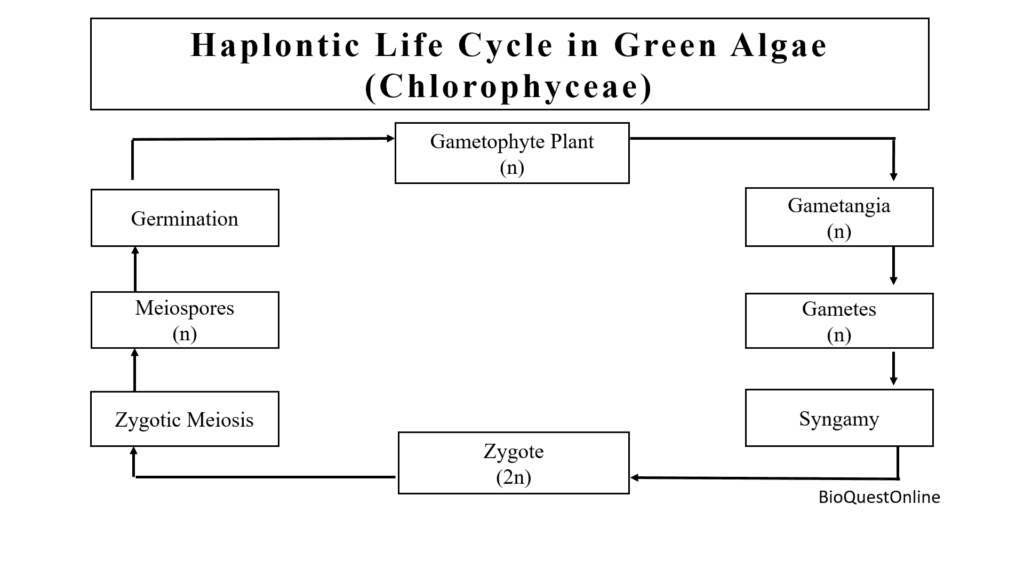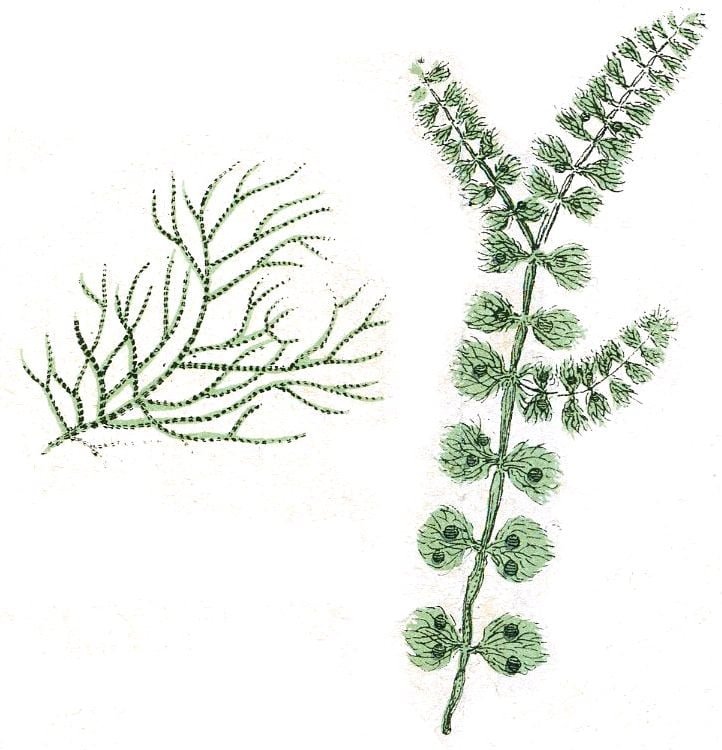Reproduction in green algae (Chlorophyceae) occurs by vegetative method (fragmentation, fission and akinete), asexual method (zoospore, aplanospores, hypnospores and autospores) or sexual methods (isogamy, anisogamy and oogamy). Depending upon the species, green algae reproduce by one or all of methods.
Most green algae exhibit a haplontic life cycle, while some, show a diplontic life cycle, and a few exhibit diplohaplontic life cycle.
Methods of Reproduction in Green Algae (Chlorophyceae)
Reproduction in green algae (Chlorophyceae) occurs through one or more of the following three methods: vegetative, asexual, and sexual method.
Vegetative Reproduction in Green Algae (Chlorophyceae)
Vegetative reproduction in green algae occurs through fragmentation, cell division, and the formation of akinetes. This process involves only vegetative cells, with the parent cell wall remaining intact after reproduction.
Numerous species predominantly reproduce through vegetative methods, which includes fragmentation, fission and akinetes.
Fragmentation
- Fragmentation involves the breaking of the thallus into two or more pieces in colonial forms (e.g., Dictyosphaerium) and filamentous forms (e.g., Spirogyra, Ulothrix, Oedogonium).
- Each fragment acts as a reproductive unit, growing into a new filament through cell division and subsequent growth of its cells.
- Fragmentation may result from external mechanical forces or the disintegration of intercalary asexual or sexual reproductive structures.
Fission
- Reproduction through ordinary cell division, also known as fission, is a common characteristic of certain Chlorophyceans, particularly unicellular forms.
- This process begins with mitotic division of the nucleus, followed by the cleavage of the cytoplasm.
- Cytoplasmic division starts with a median constriction that deepens and eventually splits the cell into two parts.
Akinetes
- Akinetes are large, single-celled, oblong, non-motile, thick-walled resting structures formed by the modification and thickening of vegetative cell walls.
- These structures are rich in stored food materials and can endure unfavorable conditions. When conditions become favorable, akinetes germinate to form new individuals.
- Akinetes are commonly found in genera like Pithophora, Ulothrix, and Chlamydomonas.

Asexual Reproduction in Green Algae (Chlorophyceae)
Asexual reproduction in green algae occurs through the formation of specialized reproductive cells known as spores. These spores are produced endogenously within specialized structures called sporangia.
They are typically formed through repeated mitotic divisions of the protoplast, making them mitospores. Mitospores, which are asexual spores, differ from sexual spores that are formed through meiosis and are referred to as meiospores. Mitospores can be either motile or non-motile.
Common types of spores include zoospores, aplanospores, hypnospores, and autospores.
Zoospores
- Asexual reproduction through zoospores is common in Chlorophyceae. Zoospores, which are flagellated asexual spores, can be biflagellate (Chlamydomonas), bi- and quadriflagellate (Ulothrix), or multiflagellate (Oedogonium).
- They develop in zoosporangia or vegetative cells, forming at night and being released in the morning.
- Each zoospore contains a nucleus, an eyespot, chloroplasts, and isokont flagella. Upon settling on a suitable substrate, they germinate into a new thallus resembling the parent.
- Zoospore formation is a highly efficient and rapid method of reproduction under favorable conditions.
Aplanospores
- Aplanospores are non-flagellated, non-motile spores that form by secreting a thin wall around themselves.
- These are essentially arrested zoospores that skip the motile phase.
- They germinate into a new individual similar to their parents.
Hypnospores
- Aplanospores that develop thick walls and store abundant food reserves under certain conditions are referred to as hypnospores.
- The thick wall allows them to enter a long resting phase and survive unfavorable conditions (Ulothrix).
Autospores
- Aplanospores that are identical in appearance to the parent cell are known as autospores (Chlorella).
Sexual Reproduction in Green Algae (Chlorophyceae)
Sexual reproduction in green algae is observed in nearly all members and involves the fusion of specialized reproductive cells called gametes. The fusion of the gametes’ cytoplasm is referred to as plasmogamy, while the fusion of their nuclei is called karyogamy or fertilization. This process results in the formation of a zygote with a diploid nucleus.
In monoecious or homothallic species, both gametes involved in fusion are produced by the same thallus, while in dioecious or heterothallic species, the gametes are produced by two separate thalli. Sexual reproduction consistently involves three stages:
(i) Gamete production
(ii) Gamete fusion (syngamy and fertilization)
(iii) Zygote germination
Sexual reproduction in green algae (Chlorophyceae) occurs in three forms: isogamy, anisogamy, and oogamy.
Isogamy
- This is the simplest form of sexual reproduction, mostly found in lower organisms.
- The gametes, known as isogametes, are morphologically identical in size, form, and structure. Isogamous reproduction is common in species like Chlamydomonas.
- Isogametes are typically naked, flagellated, and produced within ordinary vegetative cells called gametangia.
- The cell protoplast divides into several daughter protoplasts, each of which develops flagella and becomes an isogamete, which is smaller than a zoospore.
- These gametes are released into the surrounding water after the parental cell wall is digested by enzymes such as wall autolysins.
Anisogamy
- Anisogamous reproduction in green algae involves the fusion of dissimilar gametes, called anisogametes. It is divided into two types:
- Physiological Anisogamy: Found in species like Chlamydomonas monoica and Spirogyra, where the gametes are morphologically identical but differ in behavior, with one being more active than the other.
- Morphological Anisogamy: Seen in Chlamydomonas braunii, where the gametes differ noticeably in size. In most Chlorophyceae, the male gamete is small and motile, while the female gamete is large and stationary. Gametes are produced in specialized cells called gametangia and fuse externally after release. Morphological anisogamy is considered more advanced than physiological anisogamy.
Oogamy
- Oogamy is the most advanced form of sexual reproduction, occurring in higher algae. The gametes, called heterogametes, differ in size, motility, behavior, and structure.
- The male gamete is small, motile, and produced in large numbers within the antheridium, while the female gamete is large, non-motile, and retained within the oogonium.
- The sperm swims toward the egg and fuses with it to form a zygote.
- Oogamous reproduction is common in species such as Chlamydomonas coccifera, Volvox, Chlorogonium, Pandorina, and Oedocladium. The order Oedogoniales is exclusively oogamous.
- Zygote
- The wall at the point of fusion between the two gametes quickly dissolves. In isogamy, the quadriflagellate zygote swims briefly before its flagella are resorbed, and the now non-motile zygote settles down.
- At this stage, the zygote contains two nuclei, two chloroplasts, and two eyespots. It then secretes a thick wall around itself, becoming a resting spore known as a zygospore.
- The cytoplasm, nuclei, and chloroplasts of the gametes fuse, and a thick, ornamented secondary wall forms around the zygote. The zygote or zygospore is the diploid structure in the life cycle.
- In Chlorophyceae, the zygote always enters a resting stage. It accumulates fats and reserve food, turning orange-red in color. The zygote can withstand drought and waits for favorable conditions to return before it germinates.
- Germination of Zygospore:
- When the zygote encounters favorable conditions, such as water, it begins to germinate.
- The diploid nucleus of the zygote undergoes meiosis, resulting in the formation of four haploid nuclei. At this point, the nuclei of opposite mating types (+ and -) segregate.
- Zygotic Meiosis and Haploid Generation
- In Chlorophyceae (e.g., Spirogyra), the diploid nucleus of the zygote undergoes meiosis, known as zygotic meiosis. This process results in the formation of four haploid daughter nuclei, three of which degenerate.
- The protoplast of the zygote, containing the remaining haploid nucleus, directly develops into a new gametophyte filament or vegetative thallus.
- In Ulothrix and Oedogonium, zygotic meiosis takes place, but all four resulting haploid nuclei remain active.
- These functional nuclei form meiospores, which are released from the zygote and give rise to a haploid or gametophyte filament. Therefore, the filament is formed from the meiospore, not from the parent zygote.
Life Cycle in Green Algae (Chlorophyceae)
Life cycle in green algae involves a series of events that may include both sexual and asexual phases. It is characterized by the presence of sporophyte and gametophyte.
The sporophyte is diploid and produces haploid meiospores through meiosis, while the gametophyte is haploid and responsible for sexual reproduction, producing haploid gametes. Typically, the sporophyte and gametophyte alternate in a life cycle, a process known as alternation of generations.
Most green algae exhibit a haplontic life cycle, while some, like Siphonales, show a diplontic life cycle, and a few others, like Cladophora, exhibit isomorphic alternation of generations between haploid and diploid plants, known as the diplohaplontic life cycle.
Haplontic Life Cycle
- This is the simplest and most primitive life cycle type. The primary vegetative plant body (gametophyte) is haploid and is the dominant generation, producing haploid gametes.
- The fusion of gametes, known as syngamy, forms a zygote, which is the only diploid phase (sporophyte) in the cycle. The zygote undergoes meiosis, producing haploid meiospores that develop into a new haploid gametophyte.
- In this cycle, the unicellular or filamentous gametophyte alternates with the one-celled zygote or sporophyte, which is the only diploid stage. Examples include Spirogyra, Ulothrix, and Oedogonium.
- In most Chlorophyceae members (e.g., Spirogyra, Chlamydomonas, Oedogonium), the thallus is haploid and produces haploid gametes.
- These gametes fuse to form a diploid zygote, which is the only diploid structure. The diploid zygote undergoes meiosis, producing four haploid daughter nuclei, three of which disintegrate, and one remains functional.
- The functional nucleus becomes the first cell of the new haploid or gametophyte filament. In Ulothrix and Oedogonium, the zygospore divides by meiosis upon germination, forming four haploid spores.
- Each spore develops into a gametophyte filament.

Diplontic Life Cycle
- In this life cycle, gametes are haploid, and meiosis occurs during gametogenesis.
- In some species, such as Siphonales, the entire vegetative or somatic phase is diploid.
- The reduction division happens when gametes are formed. After gamete fusion, a diploid zygote is created, which then develops into a diploid plant through mitotic divisions.
- The dominant sporophyte alternates with haploid gametes, which are the only haploid stage in the life cycle. An example of this is Codium.

Diplohaplontic Life Cycle
- This life cycle involves the isomorphic alternation of haploid and diploid generations. Examples include Ulva, Cladophora, and Ectocarpus.
- In this cycle, both spore-producing multicellular sporophytes and gamete-producing gametophytes are formed, and both are free-living. The vegetative phase includes both haploid and diploid stages.
- The diploid sporophyte and haploid gametophyte are morphologically identical (isomorphic) and alternate in the life cycle.
- In this system, the zygote undergoes repeated mitotic divisions, developing into a free-living diploid filament or plant, with meiosis delayed.
- Meiosis does not occur at the time of zygote germination. Instead, meiosis produces meiospores, which develop into haploid plants.
- These haploid plants generate gametes, and their fusion forms a zygote.

You might be interested in:
Chlorophyceae; Characteristics and Range of Thallus Structure
FREQUENTLY ASKED QUESTIONS (FAQS)
What are types of reproduction in green algae?
Green algae (Chlorophyceae) reproduce through three main methods: vegetative reproduction (fragmentation, fission, and akinetes), asexual reproduction (zoospores, aplanospores, hypnospores, and autospores), and sexual reproduction (isogamy, anisogamy, and oogamy).
What are the types of asexual spores formed in Chlorophyceae?
Asexual reproduction in chlorophyceae (green algae) occurs through the formation of specialized reproductive cells known as spores. Common types of spores include zoospores, aplanospores, hypnospores, and autospores.
How do sexual reproduction occur in green algae?
Sexual reproduction is common in green algae (Chlorophyceae) and involves gamete fusion through plasmogamy (cytoplasmic fusion) and karyogamy (nuclear fusion), resulting in a diploid zygote. It occurs in three forms: isogamy, anisogamy, and oogamy.
What are the types of life cycle that occur in Chlorophyceae?
The life cycle of green algae includes sexual and asexual phases and involves sporophyte and gametophyte stages. Most pf them have a haplontic life cycle, while some, like Siphonales, are diplontic, and others, like Cladophora, exhibit a diplohaplontic life cycle with isomorphic alternation of generations.


